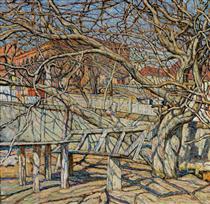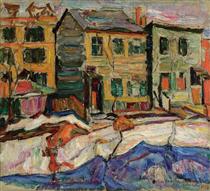
1881 - 1941
Abraham Manevich

description
Ukrainian and American artist of Jewish descent, who was born in Belarus.
Abraham lived in his homeland until the age of 20, graduated from school and went to work as a sign manufacturer. He painted furniture at the factory, where he was noticed by Nikolai Bilyashevsky, director of a museum in Kiev.
Abraham Manevich belongs to a select group of artists who mastered the art innovations of the time and stood at the origins of 20th century Ukrainian culture. Time, marked by social upheaval, determined the fate of the artist – his life journey stretched from the banks of the Dnipro river to the shores of the Hudson. In both Europe and in the United States, the artist was associated with the Ukrainian avant-garde. His works can be found in museums all over Ukraine, Russia, the USA and Israel.
Key ideas:
– The innovative art of Abraham Manevich, like a mirror, reflects the search in the early 20th century for picturesque art. Decorativeness, with a distinct Cubist style of expression, prevailed in the artist’s works. As a talented landscape painter, he reproduced the uniqueness of the land on which he lived. He was recognized as a distinguished figure in his province.
– In many of his works, the grief of his persecuted people is felt, a grief he experienced growing up in the Jewish neighborhoods of small Mstislavl in Polissya. His paintings feature the small towns of Chernihiv and Podillya (Ukraine), the neighborhoods of Solomenka, Pskov, the outskirts of Moscow, suburban America and rural Canada, and contain soft notes of sorrow and melancholy.
1881
1901
1905 - 1910
1912 - 1913
1915 - 1919
1921 - 1922
1923 - 1929
1930-е гг.
1940-е гг.
1941
The birth of the artist
Entered Kiev Art College

Study at the Munich Academy of Arts. The Trip to Europe

Participation in the Paris Autumn Salon. The personal exhibition

Personal exhibitions in Moscow

Emigrated to the USA

Exhibitions in the different cities of USA

Friendship with Albert Einstein

The terminally ill artist continued to work

The death

